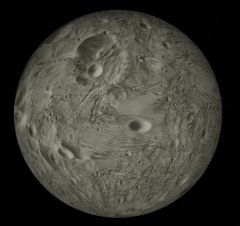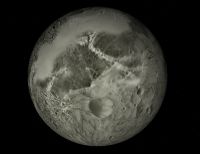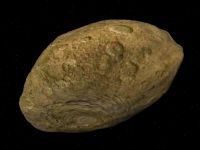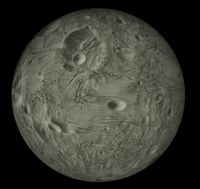Difference between revisions of "Sycorax"
(Added content.) |
(Added content.) |
||
| Line 2: | Line 2: | ||
!bgcolor="lightsteelblue" colspan="2" align="center" |Sycorax | !bgcolor="lightsteelblue" colspan="2" align="center" |Sycorax | ||
|- | |- | ||
| − | |colspan="2" align="center"|[[Image:Sycorax- | + | |colspan="2" align="center"|[[Image:Sycorax-outerplanets050125zip-Orbiter2005P1.jpg|240px]] |
|- | |- | ||
| − | |colspan="2" align="center"|<center>'''Sycorax from '' | + | |colspan="2" align="center"|<center>'''Sycorax from ''outerplanets-020125.zip'' in Orbiter 2005P1'''</center> |
|- | |- | ||
!bgcolor="lightsteelblue" colspan="2"|Designation | !bgcolor="lightsteelblue" colspan="2"|Designation | ||
| Line 14: | Line 14: | ||
!bgcolor="lightsteelblue" colspan="2"|Planetary mean orbits | !bgcolor="lightsteelblue" colspan="2"|Planetary mean orbits | ||
|- | |- | ||
| − | |width="30%"|Epoch||align="right" width="50%"| | + | |width="30%"|Epoch||align="right" width="50%"|2005.41409993155 |
|- | |- | ||
| − | |width="30%"|Semimajor axis (a)||align="right" width="50%"| | + | |width="30%"|Semimajor axis (a)||align="right" width="50%"|12185179519.9688 m |
|- | |- | ||
| − | |width="30%"|Eccentricity (e)||align="right" width="30%"|0. | + | |width="30%"|Eccentricity (e)||align="right" width="30%"|0.51586012361134 |
|- | |- | ||
| − | |width="30%"|Inclination (i)||align="right" width="30%"|152. | + | |width="30%"|Inclination (i)||align="right" width="30%"|152.4525886° <br> (2.66079962413504 radian) |
|- | |- | ||
| − | |width="30%"|Longitude of the ascending node (LAN, ☊)||align="right" width="30%"|256. | + | |width="30%"|Longitude of the ascending node (LAN, ☊)||align="right" width="30%"|256.504456294759° <br> (4.47684730838144 radian) |
|- | |- | ||
| − | |width="30%"|Longitude of periapsis (ϖ)||align="right" width="30%"|272. | + | |width="30%"|Longitude of periapsis (ϖ)||align="right" width="30%"|272.719339656917° <br> (4.75985041087795 radian) |
|- | |- | ||
| − | |width="30%"|Mean longitude (L)||align="right" width="30%"| | + | |width="30%"|Mean longitude (L)||align="right" width="30%"|369.325928329874° <br> (6.4459534623409 radian) |
|- | |- | ||
!bgcolor="lightsteelblue" colspan="2"|Selected physical parameters | !bgcolor="lightsteelblue" colspan="2"|Selected physical parameters | ||
| Line 55: | Line 55: | ||
|- | |- | ||
!Add-on!!Source!!Version!!Author!!Type!!Release Date!!Compatibility!!Wiki article | !Add-on!!Source!!Version!!Author!!Type!!Release Date!!Compatibility!!Wiki article | ||
| + | |- | ||
| + | |[https://library.avsim.net/esearch.php?DLID=&Name=&FileName=outerplanets-050125.zip&Author=&CatID=root The Outer Planets 050125]||AVSIM||050125||Rolf Keibel<br>Tony Dunn||Scenery||26 January 2005||Orbiter 2005-P1|| | ||
|- | |- | ||
|[https://www.orbiter-forum.com/resources/uranus-minor-moons.1765/ Uranus Minor Moons]||O-F Resources||2004-12-14||Nighthawke||Scenery||14 December 2004|||| | |[https://www.orbiter-forum.com/resources/uranus-minor-moons.1765/ Uranus Minor Moons]||O-F Resources||2004-12-14||Nighthawke||Scenery||14 December 2004|||| | ||
| Line 64: | Line 66: | ||
Sycorax-uranuszip.jpg|<center>Sycorax from ''uranus.zip'' in Orbiter 2002</center> | Sycorax-uranuszip.jpg|<center>Sycorax from ''uranus.zip'' in Orbiter 2002</center> | ||
Sycorax-UranusMoonszip-Orbiter2003P2.jpg|<center>Sycorax from ''UranusMoons.zip'' in Orbiter 2003P2</center> | Sycorax-UranusMoonszip-Orbiter2003P2.jpg|<center>Sycorax from ''UranusMoons.zip'' in Orbiter 2003P2</center> | ||
| + | Sycorax-outerplanets050125zip-Orbiter2005P1.jpg|<center>Sycorax from ''outerplanets-050125.zip'' in Orbiter 2005P1</center> | ||
Sycorax discovery full.jpg|<center>Discovery image of Sycorax, the circled object upper right,<br>from Wikimedia Commons</center> | Sycorax discovery full.jpg|<center>Discovery image of Sycorax, the circled object upper right,<br>from Wikimedia Commons</center> | ||
Animation of Sycorax orbit around Uranus.gif|<center>Animation of the orbits of [[Caliban]], [[Francisco]], [[Stephano]], '''Sycorax''', and [[Trinculo]],<br>from Wikimedia Commons.</center> | Animation of Sycorax orbit around Uranus.gif|<center>Animation of the orbits of [[Caliban]], [[Francisco]], [[Stephano]], '''Sycorax''', and [[Trinculo]],<br>from Wikimedia Commons.</center> | ||
Revision as of 03:30, 27 September 2024
Sycorax (Uranus XVII, S/1997 U 2) is one of the outer retrograde irregular satellites of Uranus and the largest of the irregulars. It was discovered at the Hale Telescope on 6 September 1997. It is named after the mother of Caliban in Shakespeare's The Tempest.
Sycorax in Orbiter
Sycorax was first introduced into Orbiter with the add-on uranus.zip in November 2002.
| Add-on | Source | Version | Author | Type | Release Date | Compatibility | Wiki article |
|---|---|---|---|---|---|---|---|
| The Outer Planets 050125 | AVSIM | 050125 | Rolf Keibel Tony Dunn |
Scenery | 26 January 2005 | Orbiter 2005-P1 | |
| Uranus Minor Moons | O-F Resources | 2004-12-14 | Nighthawke | Scenery | 14 December 2004 | ||
| Uranus | AVSIM | Rolf Keibel | Scenery | 5 November 2002 | |||
| Uranus's natural satellites |
|---|
| Named Satellites:
Ariel | Belinda | Bianca | Caliban | Cordelia | Cressida | Cupid | Desdemona | Ferdinand | Francisco | Juliet | Mab | Margaret | Miranda | Oberon | Ophelia | Perdita | Portia | Prospero | Puck | Rosalind | Setebos | Stephano | Sycorax | Titania | Trinculo | Umbriel Numbered Satellites: |
| See also: Pronunciation key | rings of Uranus |
| edit The Solar System | |
|---|---|
| Central star |
Sun (Sol) |
| Planets |
Mercury - Venus - Earth - Mars - Jupiter - Saturn - Uranus - Neptune |
| Natural satellites |
Moon - Phobos - Deimos - Io - Europa - Ganymede - Titan - more... |
| Add-ons |
Planets - Dwarf Planets - Small objects - Natural satellites - Alternative star systems |
 | This natural satellite related article is a stub. You can help Orbiterwiki by expanding it.
|





